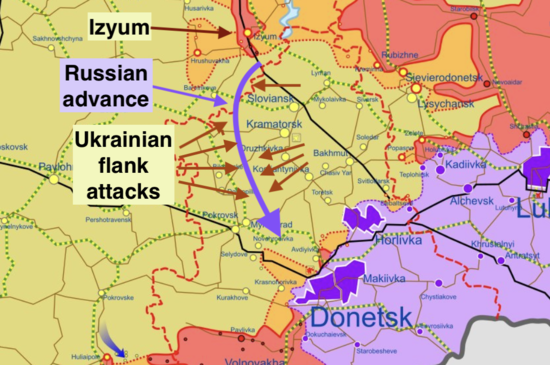Ukraine update: Reports say Russia is massing for massive Donbas attack, but can they really?
This post was originally published on this site
In recent days, both Mark Sumner and I have taken a look at the situation in Kherson (me, Mark, and more Mark). I took a close look at the Battle of Mariupol. Time to go back to the main axis of the war: the eastern Donbas front.
Aside from repeated pushes west of that purple region—pre-invasion separatist held territory—there are two Russian goals at the moment. The main one is to build on the recent capture of Izyum to push south towards Slovyiansk and Krematorsk. However, Russia seems to think that it can somehow execute a “pincer” maneuver, to trap the large number of Ukrainian defenders in highly effective defensive entrenchments along the line of contact with the purple, pre-war separatist-held region. I went into great detail on those defensive fortifications in this story, but in short, those defensive trenches have held since 2014, and repeated Russian efforts to break them have proven costly and futile. Hence, the pincer.

The obvious play would be to lay siege on Slovyiansk and Krematorsk—with short, relatively easily supply lines to defend. Problem is, it took Russia 3-4 weeks to take Izyum, pre-war population 46,000. Both Slovyiansk (pop. 111,000) and Krematorsk (pop. 157,000) are much larger, and Ukraine has had plenty of time to dig in, with the kind of defensive emplacements that have proven so successful on the Donbas front line. So rather than risk a direct assault, Russia is making the same mistake it made in the north and northeast where it bypassed major population centers to push beyond. The problem, of course, is that Russia has shown zero ability to protect supply lines, and it would take 200 kilometers (~120 miles) of territory to fully encircle the region.
Just like around Sumy, those long, extended supply lines would be chewed up.
Russia supposedly has an ace up its sleeve. According to just about everyone (Ukraine Ministry of Defense, Pentagon, UK Ministry of Defence, etc), Russia is redeploying troops from its failed Kyiv, Chernihiv, and Sumy efforts to this singular front, in preparation for a massive all-out attack.
Given what we’ve seen from Russia, I’m skeptical.
1. Russia’s forces have been shredded, and will take time to reconstitute.
Last night’s update from the Institute of the Study of War offered detailed reasons why those troops can’t be effectively redeployed so quickly. It’s worth the full read, but here’s the gist:
The dozens of Russian battalion tactical groups (BTGs) that retreated from around Kyiv likely possess combat power that is a fraction of what the numbers of units or total numbers of personnel with those units would suggest.
There are many reasons for this assessment. Smushing together broken BTGs doesn’t magically make them full power. Units need to train together to learn how to coordinate complex battlefield maneuvers under the stress of combat. Much of their replaced equipment is from substandard stock. Their soldiers are traumatized, broken, deserting their units, or outright refusing to redeploy into Ukraine. Without rest, morale will continue to plumb to new depths. And speaking of morale, these guys just suffered a devastating battlefield defeat. No propaganda can hide that from the men who were literally there. They’re not eager to go die in a different part of Ukraine.
2. Russia’s forces have truly been shredded.
There are several attempts to measure the degraded state of Russia’s military. The Pentagon confusingly says that Russia has lost 20% of its combat capabilities, but also that 29 of its BTGs have been rendered combat ineffective. Given there were around 120 to start the war, that would mean it has lost around 25% of its combat capabilities.
And even that doesn’t fully capture what “combat ineffective” means. According to this U.S. Army analysis of the Russian BTG, which I cite again and again, it takes very little to render a BTG combat ineffective:

Of a Russian BTG’s 10 tanks and 40 infantry fighting vehicles, Ukraine only needs to destroy 30%, or three tanks and 12 IFVs, to render it incapable of fully operating. Here’s what Ukraine claims is going on:
Oleksiy Arestovich, chief advisor to Ukrainian President Volodymyr Zelensky, claimed on April 9 that the Ukrainian military has destroyed 20 BTGs and rendered 40 more combat ineffective. We cannot track individual BTG effectiveness that precisely, but this estimate that approximately one-third of the 180 BTGs Russia has available in and around Ukraine are combat ineffective is consistent with what we have observed.
We’ve talked about the fog of war in assessing information, and here’s a perfect example. ISW claims 180 BTGs, Russia itself only claims 170, total, while most other sources, including the Pentagon, have said 120 are in theater, which would actually mean that half of Russia’s deployed forces have been rendered ineffective. Ukraine might have an obvious incentive to exaggerate Russian losses, but as we’ll see below, anecdotal evidence backs up their general assessment (if not the exact numbers).
3. Russia can’t mass its troops for major, coordinated attacks
ISW made an astute observation on March 9:
Individual Russian attacks at roughly regiment size reported on March 8 and March 9 may represent the scale of offensive operations Russian forces can likely conduct on this axis at any one time. The possibility of a larger and more coherent general attack either to encircle Kyiv or to assault it in the coming days remains possible, but the continued commitment of groups of two to five battalion tactical groups (BTGs) at a time makes such a large-scale general attack less likely.
This is around the time ISW realized that Russia was simply incapable of massing the kind of force necessary to make a serious play on Kyiv. I actually think ISW is being kind here with their “two to five” estimate. I don’t think we’ve seen any attack larger than a few hundred soldiers and a few dozen tanks, which would confirm Russia’s inability to coordinate more than two to three BTGs at a time.
That’s why we repeatedly see these sad, pathetic, half-assed attacks that lack the punch and heft to seriously contest strongly defended territory. And in a weird way, this confirms their core strategy, which has nothing to do with complex combined-arms tactical maneuvers to take and occupy ground. Rather, Russia “prepares” the territory ahead with artillery until there’s nothing left standing or living, then simply marches forward to occupy the rubble. It’s not totally ineffective. Russia has made some gains, but it takes time that Russia doesn’t have, damages its international standing as civilians die by the score, and ironically, it gives defenders plenty of rubble to shelter under. And quite frankly, it hasn’t worked in any major city thus far. Much of Russia’s advances have been of the “trade land for blood” variety, allowing Russia to advance forward, stretching out their supply lines, then Ukraine hitting them when they’re over-extended.
That’s exactly what happened to Russia’s famed 4th Guards Tank Division (GTD). as Ukraine harassed it into combat oblivion, wiping out or capturing over half of the most advanced tanks in the Russian army.
4. Russia is no longer fielding complete units
Those broken units pulled from Kyiv, Chernihiv, and Sumy should be rested, given R&R, and reinforced with new equipment and personnel. Problem is, Vladimir Putin is demanding his victory lap on May 9, and there are no experienced replacements available (they’re all dead, injured, AWOL, or green conscripts), and that famous Russian grift decimated their stored equipment reserves. But that May 9 WWII parade can’t be postponed, so Russia is prematurely pushing its broken units into the Donbas shredder.
Look, here’s what’s left of the 4th GTD, heading through Izyum.
Did they reconstitute? Heck no. Visual estimates by the Open Source intelligence community put the unit at around 40% of its original strength. Still formidable! But nothing compared to its former, imposing self with around 220 tanks and 400 IFVs.
But even more illustrative is this anecdote by the author of that great Rolling Stone story Mark discussed earlier, about the terrible toll of the war on Ukraine’s brave defenders.

Bishop doesn’t say where these marines are located for Operational Security (OPSEC) reasons, but we know they are on the Donbas front. Here’s what’s so amazing about that example:
- Why did Russia only send one BTG on the attack? It was part of a regiment, which should have four. Yet here they sent a lonely BTG to slaughter. A major, coordinated, massive attack might have overwhelmed tired and overstretched Ukrainian defenders, like the ones in this article. Instead, those exhausted defenders got to stop a drippy leak instead of a burst pipe. Russia can’t do a burst pipe.
- Let’s do some math: Ukraine destroyed or captured 15 IFVs and three tanks. The defenders said that was “more than half” of the attacking force. But if you look above at that chart from the US Army report, a BTG has 10 tanks and 40 IFV’s. So assuming the defenders counted correctly, that means Russia couldn’t even manage to send a full-strength BTG on that attack.
- Even worse, let’s say the defenders took out exactly half of the attacking force—that would mean 25 IFVs and 6 tanks engaged, or put another way, it was understrength by 15 IFVs and 4 tanks. As the chart above shows, you only need to destroy 3 tanks and 12 IFVs to render the BTG combat ineffective. This poor BTG was already combat ineffective the second it lurched forward into contested territory. It never stood a chance! Russia doesn’t care.
Yes, this is an anecdotal example, but we see it time and time again. The small, ineffective probes with little power, and no follow up elements to exploit any breakthroughs. Early in the war, observers thought these were “reconnaissance probes,” trying to suss out the location of defensive positions. Turns out, they were actual attacks, the most Russia could muster.
Thus, Ukraine continues to play rope-a-dope, letting the attacking BTG punch through, then slamming it from all sides. Nothing else is coming to its aid. And these attacks happen daily along this line. Three such attacks yesterday, which was a relatively quiet day, seven on Friday, at least four on Thursday, seven on Wednesday, and so on. Imagine if Russia took those 20+ attacks, and combined them into one massive push? What a crazy idea! It would inevitably be far more effective! Instead, Ukraine continues to benefit from Russia’s rank incompetence.
So will Russia’s feared major attack materialize? The obvious cop-out answer is “maybe,” but I just don’t see it. If it was coming, why would Russia be burning men and equipment on hopeless charges with piecemeal, inadequate forces? Why wouldn’t they be massing those troops for a focused, powerful assault on key Ukrainian defenses, using their sheer numerical superiority to overwhelm defenders?
Thus far, Russia has proven itself to be utterly incapable of mounting coordinated attacks with more than a handful of BTGs, most with around two. Can they somehow fix this glaring operational deficiency in the next month? I don’t see it. But, you know, maybe.
